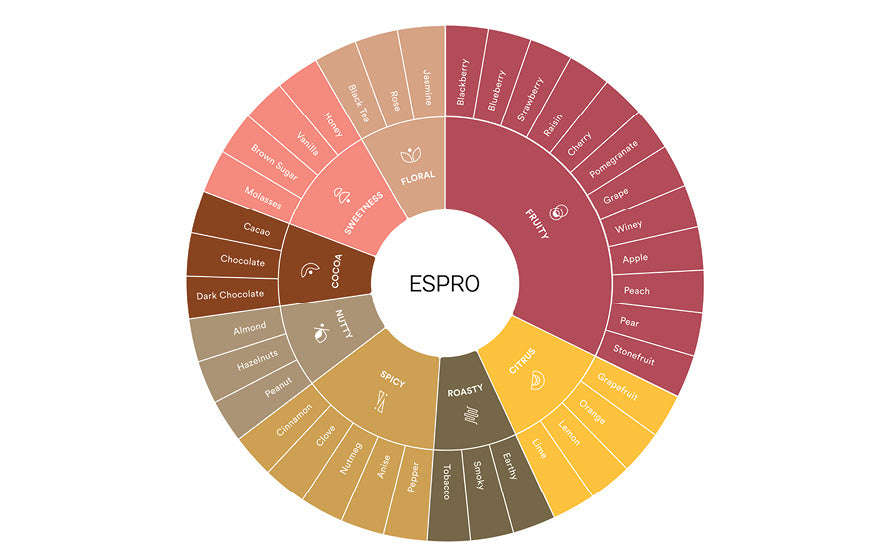Coffee is a deceptively complex drink. One wrong move and your cup transforms from an enjoyable, smooth brew to a mouth-puckering sour coffee.
Don’t worry. It happens to everyone.
You’ve suffered through sour coffee at diners, gas stations, or at home with your parent’s outdated Mr. Coffee drip pot. It’s a shock to your system, hitting your palate with unpleasant flavors that leave you dissatisfied and wondering what went wrong when brewing your coffee.
Sour-tasting coffee is a coffee tragedy no one wants to experience. Luckily, you’ve come to the right place.
We’ll show you:
-
How to discern what sour coffee tastes like (and why some acidity is a good thing)
-
The top 3 things that’ll make your coffee taste ultra-sour
-
3 easy ways to remedy sour-tasting coffee
-
How to choose flavor notes and beans you love
Ready to get rid of sour coffee? We sure are!
Here’s How to Know Your Coffee is Sour
Did you know the human tongue has anywhere from 2,000-8,000 taste buds on average? These little sensory cells are responsible for the perception of taste. Universally, flavors fall into one of five taste categories:
-
Sweet
-
Salty
-
Sour
-
Bitter
-
Umami
Sour tastes and flavors are usually received on the back edges of our tongue. If you take a sip of coffee and this part of your tongue picks up unpleasant flavors, your coffee is probably sour.
Read: Coffee Flavor 101: How to Taste Your Brew Like the Pros for Max Enjoyment
Don’t Confuse Acidity with Sourness
Now, it’s important to note that coffee naturally contains acidity. And, acidity in coffee is a good thing! But it is often confused with sour flavors.
Pleasant acidity is the difference between dull, muted coffee and bright, crisp, and vibrant-tasting coffee.
Think of acidity like carbonation in soda. Without the tangy pop of the carbonation, the soda tastes flat and boring. Without acidity, your coffee doesn’t taste exciting, as it should be!
There are four main types of acids found in coffee:
-
Citric acids - Lemon, lime, orange, citrus notes
-
Malic acids - Green apple notes
-
Phosphoric acids - Sweet, tangy notes
-
Acetic acids - Similar to the bite of sour beer or vinegar.
Coffee from around the world contains varying levels of acids, which contribute to the overall flavor profile of the cup. Beans from Brazil, for instance, typically contain less acidity resulting in a smooth, nutty, and sweet-tasting coffee. Whereas coffee beans from East African countries such as Zambia or Ethiopia contain higher levels of acids for fruity or “zingy” tasting coffees.
As with all things in life, too much of a good thing can be bad. Overly acidic coffee tastes sour and harsh. This happens when coffee is over-roasted or incorrectly brewed. This is why specialty coffee professionals aim to roast and brew coffees with acidity that highlights and compliments the natural flavor of the beans.
3 Reasons Why Your Coffee Tastes Sour
1. Under Extraction
When you make coffee, acids, sugars, oils, and other flavors from the beans are dissolved and combine with the water to create your final brew.
This process is called “extraction.” Aka, coffee brewing.
The first things to be extracted are the acids. So when you start brewing, your coffee is very sour. And if all those natural acids aren’t balanced out by the sugars, oils, and other flavors, they’ll taste overpowering (too bright and sour).
We call this “under extraction”, because the coffee wasn’t brewed enough to produce and dissolve all of the good tasting flavors from the beans for a balanced cup.
Under extraction is a fairly common problem, but it’s not complicated to fix. We’ll show you how in a minute.
2. Under Roasted Beans
The coffee roasting process starts with green coffee beans. Through the perfect balance of heat, air, rotation, and other factors, roasters transform this green bean into the coffee we know and love.
During the roasting process, the Maillard Reaction occurs. The Maillard Reaction is responsible for the “browning” of food. You’ll recognize this chemical reaction when you:
-
Turn bread into toast
-
Fry floppy bacon into crispy goodness
-
Roast coffee beans
In coffee, the Maillard Reaction turns the raw organic compounds in green coffee into delicious flavors and caramelizes the sugars. Without the Maillard Reaction, coffee tastes sour and earthy.
This means, if your coffee beans are roasted too light and don’t experience the Maillard Reaction, they’ll have a noticeably sour and almost hay-like flavor. Yuck!
If your coffee tastes sour, it may be due to under roasted (also known as underdeveloped) coffee beans.
Thankfully, this is primarily a challenge with newer coffee roasters, but one that’s becoming less and less common.
3. Stale Coffee Beans
Your coffee beans slowly break down over time. The aromatic oils evaporate. The sugars break down. And the one-delicious natural acids start to turn sour and aggressive.
Within just 3-4 weeks of being roasted, your coffee beans will start to taste less balanced. A few weeks later, they’ll start to be pretty sour. If you taste harsh lemon citrus notes, they’re completely stale. Bummer!
Fortunately, remedying sour coffee at home is simple.
3 Easy Ways to Fix Sour Coffee
One of the best parts about brewing coffee at home is the ability to experiment. If you find that your coffee tastes sour, try one of these three solutions.
1. Grind Finer
Remember how sour coffee is the result of under extraction? Under extraction can happen if your coffee particle size is too large.
Due to their size, it takes longer for water to fully saturate larger coffee particles, meaning much of the flavor is not extracted from the bean. Finer grinds, on the other hand, can extract flavor compounds quicker than coarse grinds.
If you find that your coffee tastes a bit on the sour side, grind finer for smaller coffee particles.
2. Increase the Brew Time
If you purchase ground coffee rather than whole beans, grinding finer isn’t an option. Since coarsely ground coffee requires more brew time to properly extract flavors, the easiest solution is to increase your brew time.
Sour coffee is often the result of a short brew time, leaving the sweet flavors not fully extracted from the bean. Increasing the brew time will allow all of the tasty flavor compounds to be extracted into your drink.
If you’re brewing with a french press or AeroPress, this means waiting a bit longer before you slowly plunge the grounds (it might be the easiest way to solve sour coffee). Or, if you’re a pour over fan, pour your water a little slower to increase the total time that the coffee grounds and water interact.
Read: French Press vs Pour Over Coffee: Discover Which Is Better For You
3. Raise the Coffee:Water Ratio
All coffee recipes are some variation of a coffee-to-water ratio, such as the traditional 2 tablespoons of ground coffee to 8 ounces of water recipe.
Unfortunately, this age-old recipe doesn’t work for all coffees—even if it’s a correct extraction. Some coffee blends or single origin coffees just taste too sour, even with a commonly used recipe.
This is why, ultimately, you have to trust your taste buds.
Using a coffee:water ratio with too little water results in a more concentrated brew. Naturally, this more potent cup of coffee can lead to stronger sourness.
Now, think back to our quick lesson about acidity in coffee. Acidity highlights the pleasant flavors in a coffee and is evened out with sweet notes.
When your brew recipe results in a sour coffee, increase the amount of water used. Adding more water directly increases the brew time, which results in a more even extraction to produce a cup of coffee with a softer acidity and sweet tasting notes.
It’s All About Choosing Beans You Love!
Some people, called “supertasters”, have the power to detect certain flavors stronger than other people. If you happen to be one of these individuals, you’ll be able to pick up sour notes instantly—even if they’re subtle.
This is why, no matter how sensitive your taste buds are, it’s important to choose coffee beans that you love to drink! Listen to your taste buds. They know what to do.
If sour-tasting coffee makes you wrinkle your nose in disgust, you might want to try beans with a slightly lower acidity level. Coffee from Hawaii, Brazil, Sumatra, and parts of Central America often have lower or more balanced levels of acidity.
You can also try brewing coffee blends roasted to reduce acidity. Don’t be shy! Ask your local coffee roaster which blend they recommend for a more mild tang.
Not sure what coffee flavors you prefer? Use the ESPRO tasting cups to learn more about your coffee preferences!
Don’t Settle for Sour Coffee
Fixing sour coffee is seriously easy. When in doubt, just remember to
-
Grind finer
-
Increase your brew time
-
Or use a little more water
Happy brewing!













